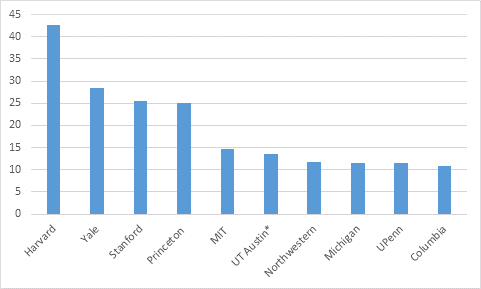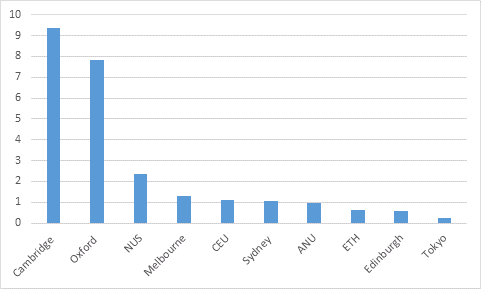Every once in awhile, when politicians of a certain mindset get going on the subject of how much money is being wasted in higher education, they fall back on a line about “why can’t universities be more self-sufficient”, or better yet, “why can’t they just fundraise more, like American universities do”?
Easier said than done. Here are the top ten Canadian universities, by endowment.
Top ten Canadian Universities by Endowment (in C$ Billion)
So you’ve got Toronto at about $2 billion in total endowments, McGill and UBC hovering at about $1.5 billion and Alberta just scraping $1 billion. After that it starts to fall off quickly. Queen’s clocks in at three-quarters of a billion while Calgary, McMaster and Western at just over half a billion (which, for comparative purposes, is somewhat less than U of T’s medical faculties alone) and then on down from there. Only twenty universities in Canada have endowments as large as $100 million. To put that another way, given the way endowments work, that means there are only 20 institutions in the country which receive as much as $4 million annually from endowment returns. Spread $4 million over, say 20,000 students and you’re looking at a grand total of about $200 per student in endowment income, which at most universities is basically a rounding error.
Now, let’s look at the top ten in the United States.
Top ten US Universities by Endowment (in C$ Billion)
Clearly, the US is a whole different ballgame here. All of the top six institutions in the US have larger endowments than all Canadian institutions combined: Harvard’s endowment alone is over three times Canada’s. (In fact, this week Harvard got its largest ever single donation, worth $400M US – which is almost exactly equal to Dalhousie’s endowment. One Donation. Seriously.)
Though the US list is mostly made up of private institutions, two publics make the top ten: Michigan and Texas-Austin. The Texas endowment story is frankly insane and too long to recount here: suffice to say that technically UT Austin doesn’t specifically have a $11.5 billion in endowments; however, the UT system as a whole has about $26 billion (not counting another $13 billion or so for Texas A&M) thanks to various funds setup by the state, and Austin seems to end up getting about 45% of that, the $11.5 figure seems like a decent estimate of Austin’s implicit claim on funds.
In some ways, it’s not even the big-endowment schools that are the craziest. The US has five Liberal Arts colleges (Pomona, Swarthmore, Amherst, Grinnell and Williams) with 2,000 students or less which have per-student endowments of over $1 million. That means these schools have per student endowment income of over $40,000 – or, about twice what a school like Bishop’s has per student from all income sources. These schools actually don’t need to charge tuition – they do so only because to do otherwise would make their programs look cheap and common.
What about the rest of the world? Well, once you get outside North America, the data on endowments gets pretty thin. Wikipedia claims to list endowment values of major universities in Europe, Asia and Australia, but for reasons that are quite baffling, on closer inspection these figures often turn out represent the institution’s annual budgets. Plus the meaning of terms like “university foundation” and “endowments” seem to mean slightly different things in different places. Top three Australian universities have Foundations which manage $1 billion or more in “long-term funds”, but not all of these funds appear to be externally endowed in the way we think of the term (the balance would appear to be funds invested by the universities themselves). Similarly, Tokyo University Foundation lists $24.8 billion yen ($250 million) in cash “and pledges” which could mean just about anything.
European universities seem not to advertise or explain their endowments, possibly because they haven’t got many of them. ETH Zurich is described on a number of websites as have a billion euros in endowments, but the most recent ETH Foundation annual report puts the figure at closer to 400 million euros. The only other continental university with a major endowment is the Central European University in Budapest, which apparently has an endowment of roughly $1 billion thanks mostly to its principal benefactor, George Soros. The UK, of course, is a different story. Oxford and Cambridge are handsomely funded but the gap between these two and everyone else is enormous – the third-best endowed school has less than a tenth of what the second-best school has.
The only two Asian universities where we have definite evidence of serious wealth are The King Abdullah University of Science and Technology (KAUST) and the National University of Singapore (NUS). The former, of course, was famously endowed to the tune of USD $20 Billion by its founder; the latter seems to have built up its formidable $2.3 Billion (Cdn) endowment in a more traditional (from a North American perspective) way, though gifts of many individual benefactors.
Major University Endowments, Selected non-North American Institutions (in C$ Billion)
Not shown: KAUST and its $20 Billion US endowment because that would make the graph look ridiculous.
All of which is to say that Canada actually does well compared to most of the world in terms of private funding raising. Our top three schools are probably in the top ten in the world outside the US in terms of total endowment size, and in terms of total university endowments, we probably come fourth in the world after the US, the UK and Saudi Arabia. The problem is simply that due to proximity we compare ourselves to the US, which is sui generis in so many ways. KAUST aside, there simply isn’t a university in the world which can support itself through donations the way American schools can. We need to stop using them as a yardstick.



 Tweet this post
Tweet this post

Thanks Alex. I really enjoy (yes. I enjoy) your posts that explore university revenue generation. For right or wrong (both probably), Revenue Diversification is probably the number one priority of universities nation wide – so you’ll never run out of topics. I’m wondering what the you think about to following contention:
U of T, UBC and McGill will soon (next 5 to 10 years) separate from the pack (reach escape velocity) – their endowments are bigger (compounded interest advantage), their fund raising campaigns are bigger, and…their biggest advantage….their capacity to increase tuition/fees…is much greater (i.e. compare U of T MBA tuition, or international student tuition for Arts and Science undergrads with U of A’s ) , because if the U of Michigan example teaches us anything, its that while endowments and fundraising are important, the ability to grow tuition/fees revenue is the most important driver of a revenue diversification. The only qualifier I’d make here is that I’m assuming that provincial ministries will not be difference makers over the next decade.
Their fundraising capacity is larger, but they also have very big student bodies, so on a per student basis the amount of extra money they are generating is still relatively small. In theory they have more capacity to generate income, but government rules on tuition make it difficult for them to do so other than through intl students (and in UBC’s case at least they;re starting to hit the wall in terms of #s). UBC’s endowment lands – which give them both a big external source of income and room to grow – will I think be the difference-maker.
I also enjoyed this, though I’m taking my time getting back. In term, I’m busy, but in summer, I suffer a lack of urgency!
Just two thoughts:
1. Note that the institutions with the largest endowments are usually the best. One might argue about causation here, but they also tend to be those with the highest levels of collegial self-governance (Harvard forced its president to resign; Oxford ruined its chancellor’s grand plans) and, perhaps related, the highest level of independence from the central government. It seems that money without strings attached is what makes great institutions.
2. You didn’t note this, but one way to create a sovereign wealth fund less likely to be raided by pork projects would be to endow universities. After a time, they could become entirely self-funding, ceasing to be a drain on the provincial budgets, and indeed stabilizing the economy through the business cycle.